
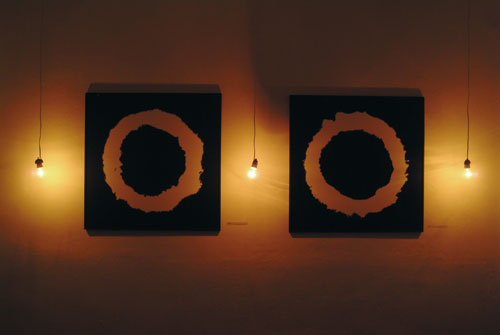
View of installation

View of installation
My Dearest Ones
Jiři Šigut
Night from March 11 to March 12, 2002
Night from March 11 to March 12, 2002
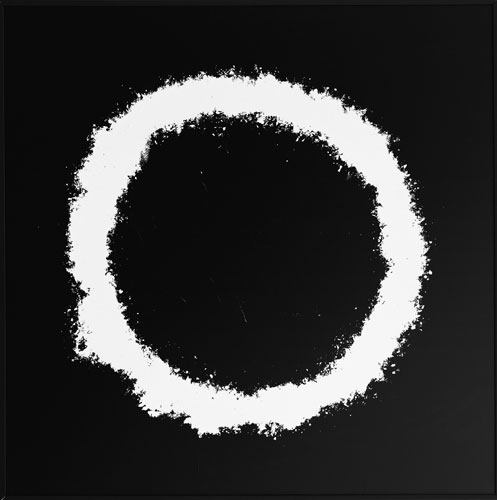
Grandmother, photographic paper, 100 x 100 cm
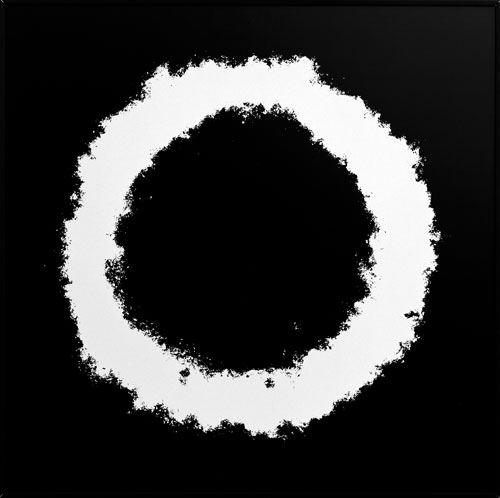
Grandfather, photographic paper, 100 x 100 cm
Notes From Shadowland
Jiři Šigut’s art seems to originate here, at the source of photography, though paradoxically he is not so much interested in photography but in the process of, if I may call it so, "long-distance" registration itself. This kind of registration is extremely interesting for Šigut because it lets him reduce or completely eliminate his own individuality from photography - his own ego. Composition, correct lighting and later even focus were not important for him even at the beginning of his career. He registered his pictures for hours on end moving freely about without a tripod, probably believing that whatever appeared before the camera would be registered one way or the other, although unclear, overexposed, underexposed or blurry. The time of exposition Šigut set on an impulse: 56 steps, 36 heartbeats or the time of a linear trip by train from Opava to Ostrava. That was his internal photometer. In this context, however, the reduction of his own participation in the process of creation seems quite disputable - because the camera is hanging about his neck, it is his heart that is beating and it is his legs that do the walking. Jiři must have realized this because his next step is an even more thorough cleansing of the images of his personal ego, and he rejects both a camera and film… Instead he has decided to register images directly on photographic paper. This breakthrough in his career begins to cut much deeper as the artist turns away from the city - from the civilized world - and towards nature. The paper he uses is very unusual - very thin but strong and supple at the same time. It is also highly light-sensitive since it was used to make copies before the invention of the xerox machine. At this stage Šigut registers images at night, lighting a fire in the middle of a sheet of photographic paper or going to sleep on paper on a moonlit night. This second stage in his career did not last very long, but the shadow of the artist remains the last tangible trace of his bodily presence in his own pictures. When the third stage starts, Šigut just lays sheets of paper directly on the ground as if making the bed in which Nature will "register itself", sometimes in exposition cycles lasting for several days. Šigut lays the paper at dusk or at night and he leaves it on the ground at the mercy of dew, rain, falling leaves, winds, rhythms of seasons, days, nights, chance and the elements. The road leading to the places where he performs his art - his nightly rovings resembling a ritual or maybe a cosmic ceremony of the unity of Ying and Yang - now become equally important to him as registration itself. And just one more thing: when so untypically long and changeable exposition is involved we also get astonishing colour effects. So we can say that we have to do here with a negative image which comes into being in effect of direct contact between light-sensitive material and Nature over a very long period of time. The picture is like a shadow of a cosmic time cycle from which the author in spite of everything has not been completely eliminated, becoming only its invisible, pulsating particle, equally small as distant stars and equally important as cosmic dust.
Šigut’s art reaches far beyond the sphere of photography as such. His works are at the same time happenings conducted without rehearsals and the possibility of having another go at it (as happening’s father, Alan Kaprow, wished), and shamanic rituals that keep man in contact with the world of spirits which we undoubtedly can come across in his later realizations. However, he will be most of all interested in the spirits of those people who used to belong to the world of the living in his own lifetime. This stage will be started by an hommage to the five miners who died in 1967 in the Michal coalmine in Ostrava, his birthplace. Jiři will visit it on the anniversary of recovering their bodies, on the 23rd of August, 2001, at night, and he will place five sheets of paper where the miners’ dead bodies had been laid. The number of candles lighting up the scene will equal the number of years that have passed since the tragedy. One of the basic tasks of the shaman’s "profession" is to guide the spirits through to the other side and to accompany them to a place chosen especially for them, where they can finally rest. And so it seems that Jiři (whose grandpa had been a miner for many long years) decided to perform such a task or at least to make us realize that such practices had been known to man in many distant places on Earth before they were colonized by religion. We know shamans to be sheer altruists as they are not going to shadowland of their own free will but rather have been chosen and invited by the spirits to visit them whenever they are needed. This way we return once more to the eternity of the universe because a shaman as the chosen one can contact "the Cosmic Tree", the Axis Mundi or the Cosmic Axis. Many artists have long tried to penetrate those spheres in their own way, ending up with quite remarkable works on the one hand and works that became road signs for others on the other, but one way or the other invited them to take a trip into dimensionlessness and timelessness. A trip into the anticipated: a trip through the fragile concrete of one being split into body and soul. It is not a coincidence that Jiři listens to the music of John Cage, one of the most controversial contemporary artists, a traveller and an orientalist, or Morton Feldman who often writes music on the verge of audibility. I would have certainly found more similar examples if I could get to know him better than life has allowed. I was his guest once in Ostrava, or speaking more precisely, I stayed in his mother’s flat since she was away in sanatorium. I would never have guessed at the time what mystery play Jiři will perform in this flat a few years later. It is March 11th, 2002, at night. Jiři has brought urns with the ashes of his parents and grandparents to his parents’ flat. Once they all used to meet here but now it is only the question of distant memories - if memory serves the still living author right. No words can describe the pain and the realization of the inevitability of one’s own end that touch us in moments like these. What was once alive is now only ashes, the ashes which in a sense are also Šigut’s ashes. He lays photographic paper on the floor, paper that is supposed to embrace and register the "portraits" of those who have passed on to the land of the shadows like a shroud. This time Jiři has planned everything even if it took him two years. First his grandparents from his mother’s side… then his parents. He sprinkles the ashes by hand: carefully, slowly… He breathes the dust of which he was born, making six circles on the floor, then lights the candles for exposition purposes. He has to watch something that is no more (though it exists) and during long exposition he has to think about what he wants to achieve by making this gesture. When he is carrying the papers to the bathtub where fresh chemicals, eager to react, await, and when he immerses his hands in it along with the paper and the dust of his last six predecessors of fate - how does he feel? And what can such an experience be if it is not a calculated provocation? The answer makes me think of Koanas which are stories or questions that interrupt the incessant chain of thought in order to offer us the possibility of enlightenment. Koanas point to the ultimate truth though they cannot be told or answered on the level of common logic, only through reaching a deeper level of its workings.
Šigut’s art is not driven by the desire or necessity of producing works/objects. From the beginning its sense - and essence - seems to lie in the process of coming into being, in which simply activity is the creative power. What can be seen in these last images is only the trace of this activity (so little and so much) while the registering itself takes place in the immaterial sphere of internal experience accessible only to a person who had the courage to try it. That is why Jiři conducts his search on the border of mysticism and shamanism and has faith in forgotten beliefs, experiences, signs and symbols.
We shall see two of his installations in Galeria GG, both very coherent expressively and saturated with symbols. Both also have directly to do with death which has been and is conceived and dealt with in different cultures completely differently. I would even risk saying that death has died for western civilization or became trivialized to the point when it is not even worth talking about. Šigut also keeps silent about death but his symbolism speaks for him. Five is one of the most important numbers in Chinese mysticism and its equivalents are five directions (the four we know plus the centre), five colours, five smells and five tastes. Lao Tse wrote: "…Five colours blind man’s eyes. Five sounds make human ears deaf. Five spices change the human palate into a wasteland…"* And there were five miners… In the instance of the circles from Najbliżsi [The Closest Family] the case seems a little more complicated because there are six circles and six seems not too important if we do not count the fact that old cosmologists linked five heavenly things with six earthly ones. And if we assume that the seventh circle belongs to the artist who is still living we must remember that the number 7 plays a significant role in… the cult of the dead. "Seven means seven periods of seven days each after man’s death when he gradually takes leave of the world of his relatives and enters the other world 49 days later". In Šigut’s art numbers are like the symbols of light, fire, blackness and whiteness… They can acquire a slightly different dimension and meaning depending on the source we have decided to use. This is because Šigut’s works are simply an invitation to a trip - but each of us can choose the road we want to travel on…
Bogdan Konopka
*Wolfram Eberhard, Symbole chińskie [Chinese symbols], Cracow 2006

View of installation
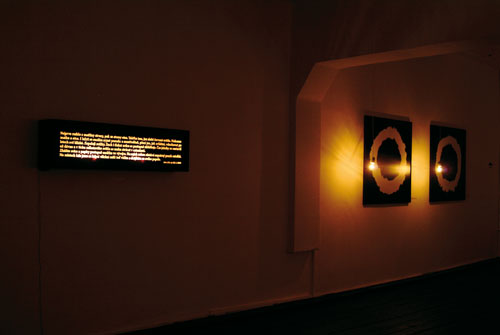
View of installation
1967/5
Jiři Šigut
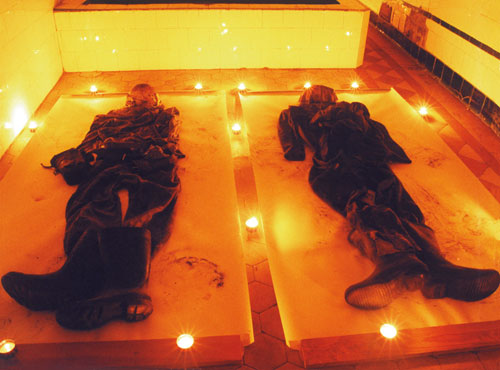
Part of implementation
Next exhibition
6.06.2008
Copyright ©2008 Galeria FF ŁDK, Jiři Šigut, Bogdan Konopka